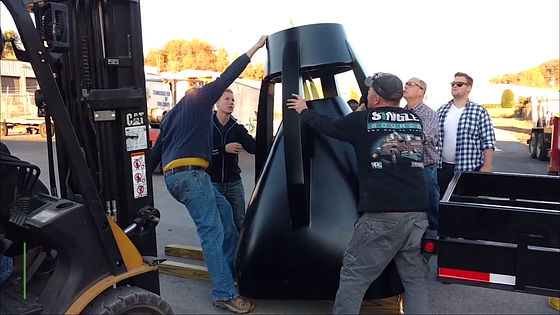A prototype of a submarine with a carbon fiber outer shell "output" using a 3D printer completed

Using a huge 3D printer, a material with characteristics of light weight and toughness · The submarine which made up the outer shell of the hull with carbon fiber is completed. This submarine was designed and created based on the hull used at the time of the operation of the US special forces "SEALs" (Shields), and by the beginning of 2019 a test aiming at completion of a hull that can actually navigate Development is to be promoted.
Large-format 3D printer builds carbon fiber-reinforced submarine: CompositesWorld
http://www.compositesworld.com/news/large-format-3d-printer-builds-carbon-fiber-reinforced-submarine
US Navy and ORNL Team Up to Develop the Military's First 3D Printed Submarine Hull on the BAAM | 3DPrint.com | The Voice of 3D Printing / Additive Manufacturing
https://3dprint.com/181795/navy-ornl-3d-printed-sub-hull/
This submarine was developed in collaboration with the US Naval Technical Research Institute, etc. by Oak Ridge National Laboratory (ORNL) of the United States, and it is called "Optionally Manned Technology Demonstrator" (OMTD). For SEALs to carry out special missions, to move underwater in secretSEAL transport submarine(SEAL Delivery Vehicle: SDV), with an overall length of 30 feet (about 9.1 meters) and a full width of 4.5 feet (about 1.37 meters).

By the way, the real SDV looks like this. SDVImproved SEAL transport systemUnlike the ASDS, the inside of the ship is filled with water, and a number of submarines wearing diving equipment and a pilot get on and move to the destination.

At the rear of the hull, a structure will be created that will accommodate the screw. First of all, the hull made first was created for Proof of Concept, after which the hull used for the actual test is supposed to be created. The stepped part on the bow is a hatch that can be opened and closed, and it seems to be put inside.


By using 3D printers, the latest technology is used for designing. The design process was promptly advanced using Microsoft's AR device "Holo Lense".

For production, a huge 3D printer manufactured by Oak Ridge National Laboratory, Manufacturing Demonstration Facility (MDF), is used to divide the hull into six pieces, and then finally assembled.

Parts of the hull part that has become sliced

The parts at the rear of the hull were also "output" with 3D printers.

Each part on which printing was done is finished in detail with individual condition, finally assembled to become one hull. In this hull, the hull was completed in about 4 weeks from the start of output. As mentioned earlier, the first machine is a concept demonstration machine made to confirm the design to the last, it is not used for actual testing. In the Navy which is promoting development, it is planned to start the experiment by preparing the second OMTD in the future.

To build a conventional SDV, it took a cost of 600,000 dollars to 800,000 dollars (about 66 million yen to 88 million yen) and a period of 3 to 5 months, but this is the case with a submarine based on this new scheme And the construction cost can be reduced by 90%, and the required number of days can be completed at just a few days level. It is attracting attention as a technology that makes it possible to drastically reduce both cost and time.

Actual production scenery etc. can be confirmed in the following movie.
Navy 3D Prints First Submersible Hull - YouTube
Related Posts:







